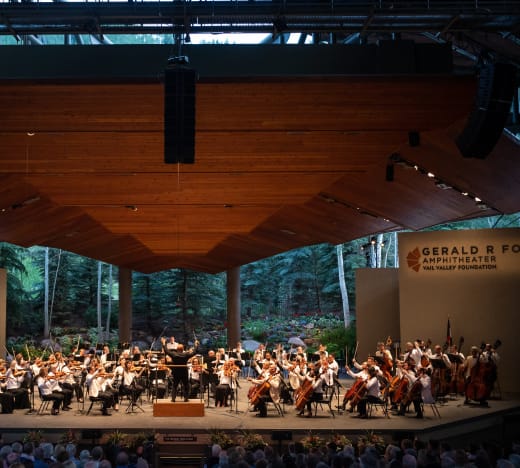
Beethoven’s Fifth with van Zweden
New York PhilharmonicMusic Director Jaap van Zweden returns to lead two of classical music’s most recognized works: Beethoven’s Symphony No. 5 and Rossini’s William Tell Overture, in a program featuring Bravo! Vail’s Anne-Marie McDermott in Mozart’s brooding Piano Concerto No. 20 in D minor.
The New York Philharmonic returns to Bravo! Vail for its annual summer residency, performing works both fresh and familiar with its signature brilliance and power.
Program Details
Jaap van Zweden, conductor
Anne-Marie McDermott, piano
ROSSINI William Tell Overture
MOZART Piano Concerto No. 20
BEETHOVEN Symphony No. 5
Guest Artists

Jaap van Zweden

Anne-Marie McDermott
Jaap van Zweden
conductor
Jaap van Zweden (conductor) became the 26th Music Director of the New York Philharmonic in 2018. He also serves as Music Director of the Hong Kong Philharmonic and in 2024 becomes Music Director of the Seoul Philharmonic. He has conducted the leading orchestras of Amsterdam, Berlin, Leipzig, London, Paris, and Vienna, plus those in Chicago, Cleveland, and Los Angeles. His NY Phil tenure includes the reopening of David Geffen Hall, as well as premieres of 31 works. His 2023/24 farewell season celebrates his connection with the Orchestra’s musicians and revisits the composers he has championed, from Steve Reich and Joel Thompson to Mozart and Mahler.

Anne-Marie McDermott
piano
Anne-Marie McDermott (piano) has been Bravo! Vail’s Artistic Director since 2011. Last summer, she performed the Vail premiere of Chris Rogerson’s Dream Sequence with the Dover Quartet, as well as the world premiere of Samaa’ (a piano concerto, also by Rogerson), commissioned by Bravo! Vail in celebration of her 10th year as Artistic Director. She regularly performs with the Chamber Music Society of Lincoln Center, where she has been a member since 1995, and has recorded extensively for Bridge Records. This fall she performs with the New York Philharmonic and Jaap van Zweden in the season opening of The McKnight Center of the Performing Arts at Oklahoma State University.

Program Notes
William Tell Overture (1829)
GIOACHINO ROSSINI (1792-1868)
William Tell Overture
In 1824, Gioachino Rossini left his native Italy to take up residence in France, contracting with the French Government to compose a grand opéra for the Paris Opéra. He settled on Friedrich von Schiller’s famous play Wilhelm Tell, which dealt with the revolt of the Swiss forest cantons against the oppressive rule of the Habsburg Dynasty. A superstar of the opera world, he had amassed enough wealth to secure an entirely comfortable future and was starting to think about early retirement, but he had one last masterpiece in him. “Tell is the first [grand] opéra that Rossini has written expressly for the French stage,” a Parisian newspaper reported in September 1828, when Rossini had started work on the piece, “and perhaps it will be the last of his compositions, he having manifested the intention of discarding his pen and retiring … to enjoy in peace his glory and his well-earned fortune.”
Guillaume Tell is rarely produced due to its inordinate length, but its overture quickly became a standard concert item. Whereas most Rossini overtures have little connection to the action of their operas, this one is structured as four self-contained episodes specifically prefiguring the action—and some of the musical content—that would follow. It opens with a pastoral depiction of the Swiss countryside, starting with the imaginative orchestration of five solo cellos; Hector Berlioz was especially enamored of these pages, which he heard as suggesting the “silence of nature when the elements and the human passions are at rest.” There follows a storm on the lake, a bucolic ranz des vaches (a herdsman’s melody) played by solo English horn with a birdlike flute warbling above, and a spirited final section that would become one of classical music’s most famous melodies.
Piano Concerto No. 20 in D minor, K.466 (1785)
WOLFGANG AMADEUS (1756-91)
Piano Concerto No. 20 in D minor, K. 466
Allegro
Romance
Rondo: Allegro assai
Intermission
Symphony No. 5 in C minor, Op. 67 (1804-08)
LUDWIG VAN BEETHOVEN (1770-1827)
Symphony No. 5 in C minor, Op. 67
Allegro con brio
Andante con moto
Allegro [attacca]
Allegro
No work in the orchestral canon has been analyzed and discussed more exhaustively than Beethoven’s Fifth Symphony, but familiarity has not made it any less potent. Wrote Robert Schumann, “No matter how frequently heard, whether at home or in the concert hall, this symphony invariably wields its power over people of every age like those great phenomena of nature that fill us with fear and admiration at all times, no matter how frequently we may experience them.”
In this music we may imagine Beethoven’s state of mind during the four-year period in which he wrote this symphony. He was losing his hearing—a great adversity for anyone, but a catastrophe for a musician. In March 1808, about when he finished this work, a raging infection threatened the loss of a finger, which would have spelled further disaster for a musician greatly attached to the keyboard. He was surrounded by a nervous political climate as Vienna bent beneath Napoleon’s occupation beginning in November 1805. In late 1807 he found himself rejected in love, and his personal life was generally chaotic: in the course of 1808 he moved to no fewer than four apartments. But there was also a calmer side to his being. He frequently escaped to the suburban parks and countryside surrounding Vienna; that’s where we imagine the composer when we hear his Sixth Symphony, the Pastoral, which was roughly coeval to the Fifth. We are not necessarily wrong to suppose that biographical overtones reside in Beethoven’s Fifth Symphony, but we shouldn’t be blind to the sheer breadth of character they cover. When all is said and done, this is a unique work, just as all of Beethoven’s masterpieces are, a vehicle in which the composer explores and works out strictly aesthetic challenges that he has set for himself.
Did you know?
The New York Philharmonic returns to Bravo! Vail in 2023 for its 20th annual summer residency, performing works both fresh and familiar with its signature brilliance and power.
All artists, programs, and pricing are subject to change.
